ZAGREB
- Introduction
Zagreb – city with a million hearts
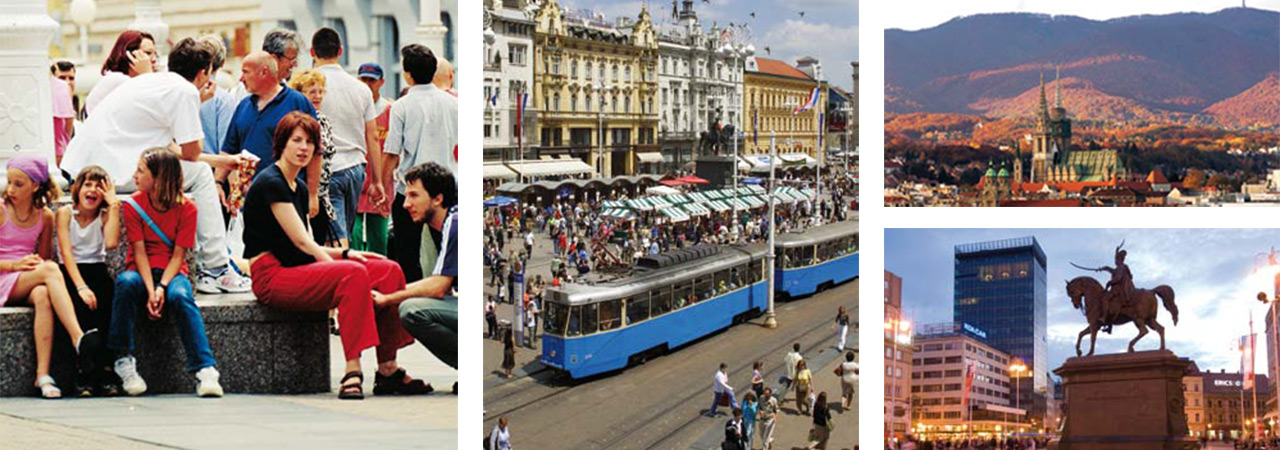
The city of Zagreb, capital of Croatia, on the historic and political threshold between East and West, illustrates both the continental and Mediterranean spirit of the nation it spearheads. Zagreb is the cultural, scientific, economic, political and administrative centre of the Republic of Croatia, and is home to the Croatian Parliament, Government and President. Its favourable location between the Pannonian plain, the edge of the Alps and the Dinaric range has allowed it to become a crossing point for mass international communication.
The city is protected from the cold northern winds by the mountain of Medvednica and opens up to the rest of the world thanks to a spacious plain and the Sava river. Zagreb, with a population of nearly one million, contains almost a quarter of the entire population of Croatia. Over the centuries, the city was inhabited by people coming from all over Europe; and, in recent years, by people coming from different parts of Croatia, ensuring a rich cultural life. Zagreb is a safe city whose doors are always open; a city with a tumultuous history teeming with interesting personalities;
a city that warmly invites all those who wish to get to know it, and a city that will surely fulfill your expectations. In this city, you can easily meet remarkable people, make new friends and enjoy special moments. The façades of Zagreb’s buildings reflect the ebb and flow of history, while its streets and squares bear witness to the coming together of the many cultures that have shaped the identity of this laid-back capital. The best thing to do is when you first arrive is to take in Zagreb’s wonderful atmosphere, which, as many claim, is only surpassed by the legendary beauty of the local womenfolk.
HistoryThe two hills of Zagreb
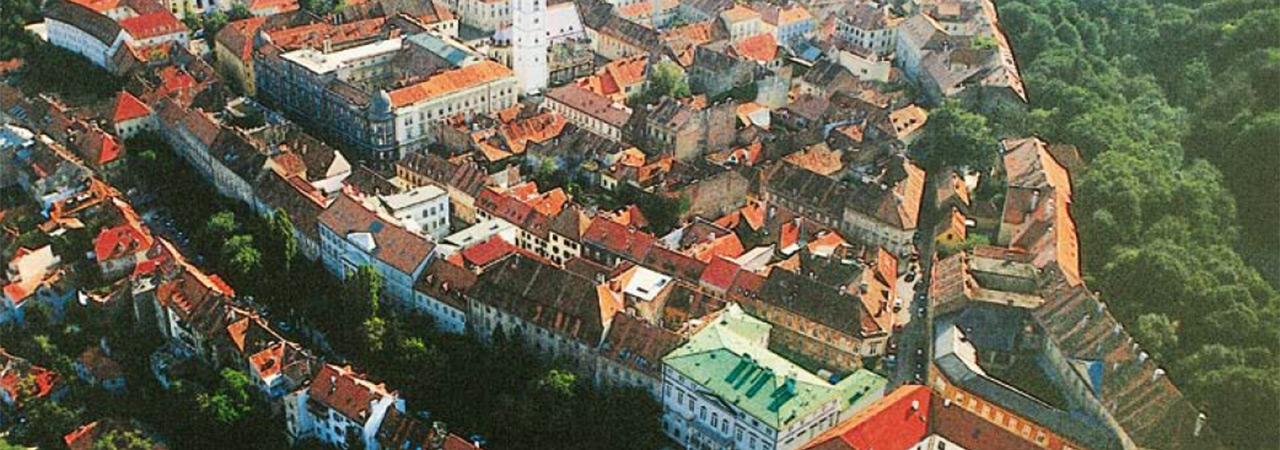
Archeological discoveries dating back to around 35,000 B.C. during the Stone Age have been discovered in the vicinity of present-day Zagreb, while later finds show evidence of the Illyrians’ arrival in this part of Europe. The Celts later moved in from the far north, presumably in the fourth century B.C.. They were succeeded by the Romans who built a large urban centre called Andautonia and whose remains have been preserved in the archeological park of Ščitarjevo. Zagreb as we know it today, which is to say its historical centre, dates back to the Middle Ages, and the settlements on two hills: secular Gradec, today known as the Upper Town; and ecclesiastical Kaptol. The first written record of Zagreb dates back to 1094 when the Hungarian king Ladislav established the Kaptol diocese on his way to the Adriatic Sea. The Zagreb Cathedral still dominates the skyline with its neo-Gothic style, while the Renaissance walls surrounding it are rare preserved examples of their kind in this part of Europe.
During the Mongol invasions of central Europe another historic event occurred here, and one that would greatly impact on Gradec, the other half of Zagreb’s core. In the mid-13th century the Tatars ravaged Hungary and their king Béla IV fled to Zagreb where its citizens provided him with a refuge. In gratitude, in 1242 Béla gave Gradec a charter proclaiming it a free royal city. His generosity is symbolically reenacted every day by the blasting of the cannon at noon from the Lotrščak tower overlooking central Zagreb. In the Middle Ages bells were sounded to warn the citizens to return to the fort as the gates to the city were about to be closed and locked. The only gate preserved from the Middle Ages, Kamenita vrata, was burned down in the first half of the 18th century. Miraculously, the only thing saved in the fire was an icon of the Virgin Mary that still occupies its prime spot in the wall.
Our Lady of Kamenita Vrata is celebrated as the patron saint of Zagreb and her feast is on the 31st of May when a ceremonial procession is organised. The occasion is also used as the City of Zagreb Day. The two hills, adversaries in the Middle Ages, were separated by the Medveščak creek and its mills. The creek valley sat along the presentday street of Tkalčićeva and it still runs underneath it, out towards the river Sava. In time the threats of attack subsided and the city started to spread out around the valley. A trading centre below the two settlements evolved into what is now the main square of Ban Josip Jelačić. This is the heart of the city and a meeting point for all Zagreb citizens. There is also a legend of how the city was named. On a sunny day, a brave governor, exhausted and thirsty from battle, asked a girl named Manda to ladle (zagrabiti) him out some water from the spring. This became Manduševac and the city became Zagreb.
The unified city of Zagreb

The twin settlements on the hills prospered. Baroque mansions and churches were built in the 17th and 18th centuries. The Jesuit order built St. Catherine’s Church, considered one of the best preserved examples of Baroque ecclesiastical splendour. In the second half of the 17th century, Zagreb became a university centre, one of the longest existing in Europe. In the meantime, Zagreb also became the seat of government. Differences between the ecclesiastical city and the free royal borough slowly disappeared and the two finally merged in 1850 to form the unified city of Zagreb, with a population of 15,000. The new city’s position enabled unhindered growth and Zagreb soon spread around the valley of the river Sava. The development of industrial production, commerce, transport and banking during the second half of the 19th century made their mark on the city’s appearance.
In 1862 Zagreb expanded to the railway that has connected it with all other central European capitals to the present day. This is when the city started to develop along gridlines. The townplanning scheme strictly outlined that all streets must be straight and of the same width, and all buildings of the same type and height. Spacious squares and monuments in the neo-styles of the 19th century are seen among the many parks and green spaces that comprise the appearance of present-day Zagreb. Praška leads us away from the main square to the so-called Green Horseshoe. This series of open green spaces, not unlike the Ring in Vienna, is formed in the shape of the letter ‘u’ and contains important institutions of public culture. The ratio of greenery to the urban architecture, fountains and pavilions was carefully planned out.
This is where the main railway station, Glavni kolodvor, is located, as well as the Academy of Sciences and Arts, the University Library, the National Theatre, noblemen’s palaces and numerous colleges. Yellow-tinted façades and lines of wild chestnut trees echo the era when Croatia was part of the Austro-Hungarian dual monarchy. The old Upper Town evolved into a systematically organised area with clearly defined sections of greenery and carefully located monuments. Building entrances around the Lower Town provide a link between public thoroughfares and the private sphere of residential courtyards. This atmospheric mix of small town and luxurious Central-European metropolis raised Zagreb to the level of contemporary cities to be reckoned with during the nineteenth century.
Modern times
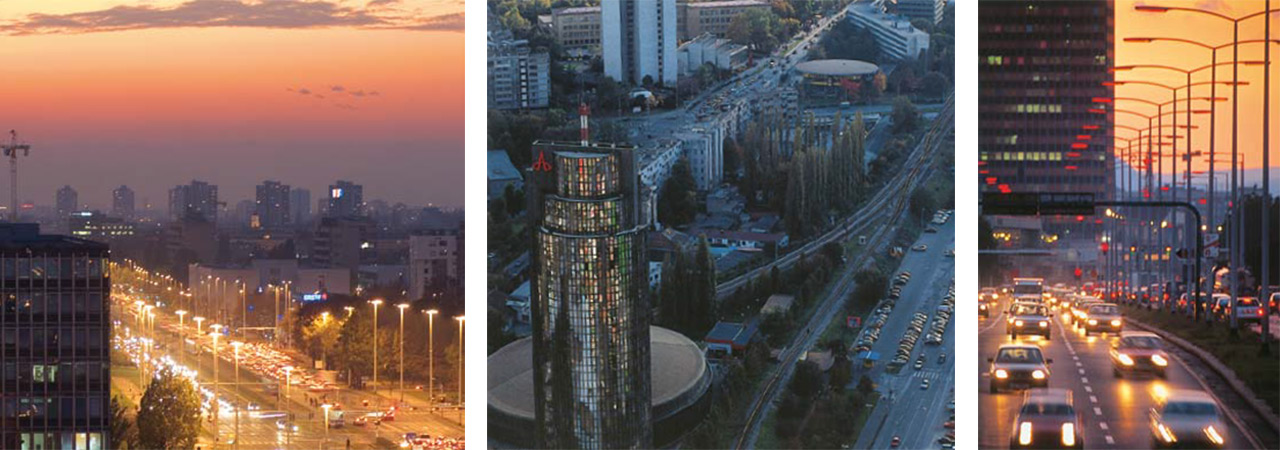
The historic events of the 20th century transformed the map of the world and left a mark on the lives of citizens of Zagreb. In 1918, after the World War I, Croatia severed all bonds with the Austro-Hungarian Monarchy and became a part of the Kingdom of Serbs, Croats and Slovenes, a new state formed by the south Slav peoples. The population of Zagreb increased and new districts emerged in the eastern and western parts of the city, while impressive residences were built in the foothills of Sljeme. In this early part of the 20th century, Zagreb developed close links with other European centres of art, culture and science. It was at this point that the first radio station in this part of Europe began to broadcast; the Zagreb Stock Exchange opened; the first automatic telephone exchange was built, as well as the city’s first skyscraper.
Modern times continued to change the everyday life of local citizens until the outbreak of World War II. After the war Croatia, with Zagreb as its capital, became one of the six republics of Yugoslavia. The post-war years lead to the further expansion of the city. It finally spread over the south bank of the river Sava with the construction of residential blocks. For centuries, the Sava had been flooding the valley while protecting citizens from medieval invasion and serving as a link to distant lands. From the mid-20th century it became the border between the old town of Zagreb and Novi Zagreb. Today there are twelve bridges connecting north and south, new and old. The Zagreb Fair, a venue for international business conventions, moved across to the south bank of the river. Pleso airport was built in the valley; around town, office blocks sprang up, along with a new National and University Library.
In 1991 the Croatian Parliament proclaimed the independence of Croatia as a sovereign state. Zagreb became the capital of a newly independent European nation, in a society of free and equal citizens. The Parliament of Croatia and the Government have their seat in the Upper Town, the oldest secular centre of the city, where historic decisions have been made for centuries. In the new millennium, the city of Zagreb is the business centre of the region, a place for multilingual business communication, political debate and cultural exchange. Business quarters just outside metropolitan Zagreb are a response to the demands of modern life. Zagreb continues to be as involved in events in Europe and the world, as it always has done.
Parks and GardensGreen Zagreb

You can find spaces for recreation almost anywhere around Zagreb. Also within easy reach we find Medvednica, a popular destination for outings. Right in the city centre, parks, streets and squares intersect with green spaces and gardens. Landscaped in the 19th century, Strossmayer Promenade in the Upper Town is where you can enjoy a romantic panorama of Zagreb accompanied by the poet A.G. Matoš, in sculpture form. Further evidence of 19th-century urban planning is provided by the so-called Green Horseshoe. This line of eight green squares created by Lenuci serves as the axis of the Lower Town. One of the most popular is Zrinjevac, known for its row of plane trees brought in from Trieste more than a century ago. Fountains, a music pavilion and busts of notable figures take us back to that time.
There is also a meteorological display which citizens of Zagreb use to check the time, the daily temperature, local air pressure and humidity. Those arriving by train are first greeted by lovely views of King Tomislav square, named after the first Croatian king; the Art Pavilion and Zagreb Cathedral. The Art Pavilion, venue for special cultural events, was originally the Croatian Pavilion at the Millennium Exhibition in Budapest in 1896. Its innovative iron construction made it possible to transport it to its present location and for it to open to the Zagreb public two years later. Nearby nestles another green oasis, the Botanical Gardens, containing one of the most splendid plant collections in Europe, with some 10,000 varieties.
Behind the walls of the Cathedral you’ll find Ribnjak, ‘Fishpond’, a park where clergymen used to catch fish for their Friday meal. In the eastern part of the city stretches spacious Maksimir. Zagreb’s biggest park was landscaped in the 19th century, in what was considered the English style. It later became home to many animals when a zoo was opened here in the first half of the 20th century. Outside the limits of the city centre, up on the hill, stands the main cemetery of Mirogoj. Its monumental arcades, pavilions and domes were designed in the late 19th century by prominent architect Hermann Bollé. One of the most beautiful cemeteries in Europe and the resting place for many public figures, Mirogoj is a lovely park in its own right, as well as an open-air art gallery.
Art, culture and eventsCity of art

Zagreb enjoys a rich cultural life. Around 30 theatres are active in the city, some with regular programmes, some occasional. Along with some 30 museums, a large number of galleries and many theatre, music and dance festivals all combine to make Zagreb a city of art. From classical to alternative, from amateur to professional, from private to public, these different artistic outlets reflect the high level of cultural awareness. The Croatian National Theatre is the national home of ballet, opera and drama. Of all the concert halls, the most prominent is the Vatroslav Lisinski, named after the composer of the first Croatian opera. Operettas and musicals, rock and pop operas can be found in the Komedija Theatre; quick-witted humour and satire are staged at Kerempuh, and contemporary productions are shown at Gavella, ZKM, ITD, and EXIT. It would be impossible to list every venue, let alone suggest the best – find one that suits you. Zagreb hosts many international cultural events.
The World Festival of Animated Film Animafest is the second oldest of its kind in Europe. The Music Biennial, the Dance Week Festival and Eurokaz, an international festival of modern theatre, bring performers from around the world to the stages of Zagreb. As we have already seen, the history, art and culture of Zagreb, Croatia and Europe are reflected in the architecture around the city, as well as in its varied museums. The Archeological Museum contains the mysterious mummy of a woman from Thebes in Egypt, wrapped in linen – the longest text in Etruscan still to be decrypted. The Zagreb City Museum brings a modern interpretation of historical events in the city from prehistoric times to the present day. The Museum of Arts and Crafts was founded together with a school in the same discipline in the second half of the 19th century, both established to preserve the traditional values of craftsmanship. A unique collection from different areas and periods has been on display at the Mimara Museum since the University Games were held in Zagreb in 1987.
The Strossmayer Gallery of Old Masters houses a collection of works by famous painters and is an essential stop for connoisseurs of European art from the 15th to 19th centuries. Nearby we find the Modern Gallery, in which works by every significant artist from the 19th and the 20th centuries are exhibited. Zagreb has also entered the 21st century with a new building for the Museum of Contemporary Art, now opening to the public. In the Upper Town, the Klović Gallery is housed in a former Jesuit monastery. For emotion, raw life and symbolism, visit the Museum of Naïve Art, with its display of works by non-academic painters. Nearby is the Atelier Meštrović, a gallery where sculptor Ivan Meštrović used to live and create work that marked the 20th century just as profoundly as Rodin’s. The circular pavilion that is now the Hall of Croatian Artists was built on the basis of his idea. These are only some of the venues and events to give you the flavour of the rich cultural life of the city.
Sports, recreation and leisure timeBlue Zagreb White Zagreb

Blue is the colour of Zagreb. It is found on the coat of arms, on city trams, buses and the funicular, while the shirts of its sportsmen are also the same colour. The people of Zagreb have always been passionate about sport, especially football. Dinamo, the football club with the most trophies in Croatia, also has blue as its team colour. Centres for recreation and professional sports can be found all around the city. The Cibona Basketball Club plays in a sports hall named after the legendary player Dražen Petrović. In addition, what used to be a branch of the Sava river is now the Jarun Recreational Sports Centre, built for the 1987 University Games.
Here you’ll find cycle paths, footpaths and sports courts for everyone to use – international rowing competitions take place on the lake. At Jarun there is also small patch of undisturbed nature, home to several hundreds of species of birds, fish, water animals and insects. A large catfish called Jura might just be an urban myth but anglers who fish here do hope to catch something big. In summer, Jarun is referred to as the Zagreb Sea, as its beaches fill with sun worshippers. Sport carries on through the winter.
At the beginning of the year Zagreb hosts the Ski World Cup, justifying another of its names, White Zagreb. Only half-an-hour from the city’s main square of Ban Josip Jelačić we find the highest peak of Medvednica Mountain, Sljeme (1035 metres), which holds a special place in the hearts of the people of Zagreb. This is where famous Croatian skiers and siblings Ivica and Janica Kostelić trained for their many medals and trophies. Their promotion of the ski run at Sljeme led to it being included in the World Cup schedule. Sljeme is also a favourite place for outings, whatever the season.
Lifestyle, gastronomy and shoppingLounge culture

Zagreb can be described as a city with the biggest lounge. The moment the sun appears in the sky in spring, restaurant, café and coffeehouse terraces open for custom. Streets become promenades, places to get a cup of coffee, relax or have a business meeting. A combination of Mediterranean cordiality and northern business sense make any visitor feel welcome. The traditional International Folklore Festival, the global festival of street performers Cest is d’Best, outdoor summer concerts on Zrinjevac, St. Martin’s Day and many other open-air events increase the feeling of communality.
Lounging in cafés has been a long tradition in this city. The Zagreb Green Horseshoe and the main square of Ban Josip Jelačić have always been hubs of social life in Zagreb. Nowadays, this has spread across the whole city centre, around the pedestrianised zone and even further. People from all walks of life can find something of interest here. Cafés around Ban Jelačić, or simply ‘Square’ as it is often referred to, attract prominent figures. Preradović, also known as Flower Square, is loved by artists and young people, as well as an older crowd. Tkalčićeva, once the border between Gradec and Kaptol, used to be full of pubs and served as the red-light district, but nowadays it is a trendy destination for rendezvous and relaxation for the whole family.
The romantic among you can take the funicular on Ilica, the shortest one in the world used for public transportation – you’ll reach the Upper Town in 55 seconds. All of these locations form part of the phenomenon known as špica. Every Saturday around noon people of all ages come to the centre because that is the time and place to see and be seen. The ritual is always the same: people slowly sip coffee, read the Saturday papers, stop off at Dolac market to pick up fresh produce and then go home to prepare lunch. In every neighbourhood there is a favourite meeting place where regulars feel welcome and where everybody knows your name.
Flavours, colours and smells

The gastronomic selection in Zagreb comprises a rich combination of many cuisines. History and geography have had a great impact on menus here. Although the people of Zagreb gladly cook at home, there are many places in town where you can find specialities of inland Croatia as well as Mediterranean and international cuisine. Štrukli is one of the authentic dishes anyone in Zagreb would recommend. There are several different ways of preparation so it can be cooked or baked, sweet or salty. Turkey with mlinci pasta strips is one of the traditional meals of inland Croatia. There is also Zagreb steak, a piece of fried veal filled with cheese and ham, somewhat similar to its renowned Vienna counterpart.
For breakfast you should try fresh cream with cheese bought directly from the producer, the so-called kumica, from villages around Zagreb. Another feature of the city are its open-air food markets. Almost every neighbourhood has one but the Dolac, near the Cathedral, is the best known. This is where producers sell fresh fruit and vegetables, meat and fish daily. The Dolac is a unique place, the so-called ‘The Belly of Zagreb’, where lovers of good food come to find seasonal products from all parts of Croatia. There you will encounter a mass of colours, smells and sounds. During the day eateries by the market offer cheap, fast, home-made dishes. There are cake shops and bakeries on every corner.
We recommend you visit one of the numerous restaurants that offer regional cuisine. You should certainly try Zagreb strudel with apples, cheese or cherries, and there is also kremšnita, the most famous creamcake made in the nearby town of Samobor. We should not leave without mentioning the praised wines made from grapes grown near Zagreb. Even though beer is the most popular drink, wine has always been very important in Zagreb, and proof is in the celebration of St. Martin’s Day. The holiday of this patron saint of wine falls on the 11th of November.
From Zagreb with love

An original souvenir from a visit to Zagreb is a tie, a must-have item of clothing in the business world and an authentic Croatian product. In the 17th century Croatian soldiers used to tie elegant scarves around their necks, a fashion later picked up by the French –the rest is history. One of the most important inventions of the 20th century, the fountain pen, was actually designed in Zagreb. Its inventor, engineer Eduard Slavoljub Penkala, patented the world’s first mechanical pencil in 1906 and in 1907 he patented the first fountain pen. He produced them in Zagreb and exported them to 70 countries around the world.
This pioneer of modern times has about 80 inventions to his name, even some in the field of aeronautics. In 1910, only a couple of years after the Wright Brothers, Penkala designed Croatia’s first aeroplane. The aromatic biscuit paprenjak, once made by the women of old Zagreb, is another original souvenir. It is an unusual combination of honey, walnuts and pepper and a reminder of the contrasts we find in Zagreb. The licitar, a traditional, colourfully adorned biscuit made from honey dough, originates from central Croatia and the lowlands. As it is heart-shaped, it should be given as a symbol of love and affection for special occasions.
Red Šestine umbrellas, a part of traditional local attire, protect the traders at the Dolac market from sun and rain. They too form a prominent part of the city’s identity. For those interested in antiques and works of art, there is a market every weekend at Britanski trg. Zagreb is a city where you can browse in small traditional shops or at contemporary boutiques on the most famous street in the city, Ilica – or look for something in the main shopping malls. Zagreb is a city that always holds a special place in the hearts of those who visit it
- A Brief History of Zagreb
A Brief History of Zagreb
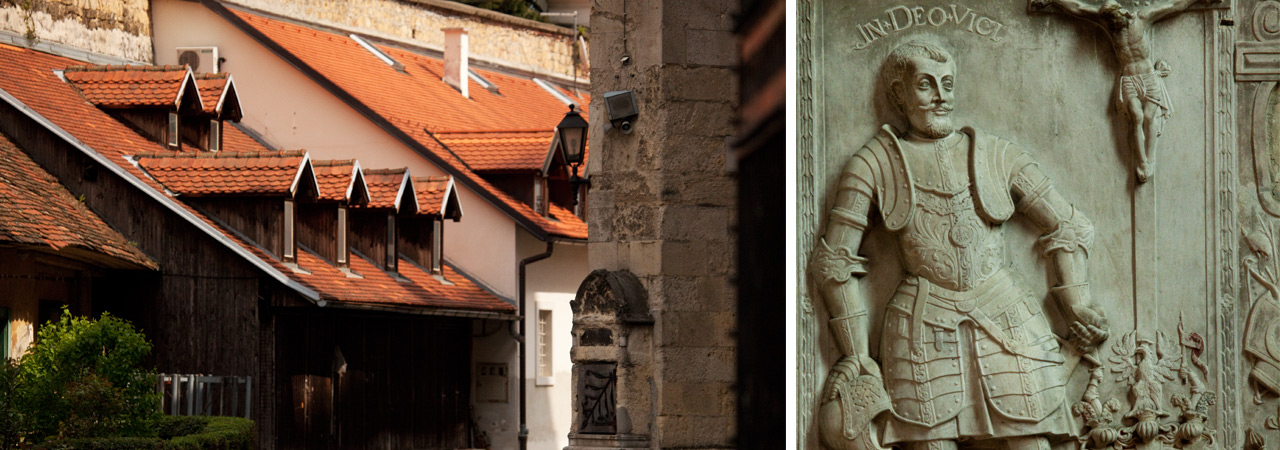
Today’s Zagreb has grown out of two medieval settlements that for centuries developed on neighbouring hills. The first written mention of the city dates from 1094, when a diocese was founded on Kaptol, while in 1242, neighbouring Gradec was proclaimed a free and royal city. Both the settlements were surrounded by high walls and towers, remains of which are still preserved.
During the Turkish onslaughts on Europe, between the 14th and 18th centuries, Zagreb was an important border fortress. The Baroque reconstruction of the city in the 17th and 18th centuries changed the appearance of the city. The old wooden houses were demolished, opulent palaces, monasteries and churches were built. The many trade fairs, the revenues from landed estates and the offerings of the many craft workshops greatly contributed to the wealth of the city.
Affluent aristocratic families, royal officials, church dignitaries and rich traders from the whole of Europe moved into the city. Schools and hospitals were opened, and the manners of European capitals were adopted. The city outgrew its medieval borders and spread to the lowlands. The first parks and country houses were built. Zagreb confirmed its position as the administrative, cultural and economic centre of Croatia.
When Kaptol, Gradec and the surrounding settlements were administratively combined into the integrated city of Zagreb in 1850, the development accelerated still more. The disastrous earthquake of 1880 sparked off the reconstruction and modernization of many shabby neighbourhoods and buildings. Prestigious public buildings were erected, parks and fountains were made, and transportation and other infrastructures were organized.
In the 19th century the population increased tenfold. The twentieth century brought the Secession style to Zagreb. The city lived in the plenty of a civil society, with firm links with all the central European centres. With an increase in wealth and industry from the 1960s on, the city spread out over the wide plains alongside the Sava River, where a new, contemporary business city has develop.
Overview of Important Historical Events
[table caption=”” width=”100%” colwidth=”25%|75%” colalign=”left|left”]
YEAR, EVENT
ca 600 AD, “Decline of the ancient Roman settlement of Scitarjevo (Andautonia). Arrival of the Croats. The earliest evidence of their existence in this area are the graves on Visoki Brijeg in Velika Gorica.”
879., “Decline of the ancient Roman settlement of Scitarjevo (Andautonia). Arrival of the Croats. The earliest evidence of their existence in this area are the graves on Visoki Brijeg in Velika Gorica.”
1094., “The Hungarian King Ladislas establishes the Zagreb Diocese.”
1134., “Issue of Felicianus’ Charter mentioning the founder of the Diocese, King Ladislas, the first bishop of, Zagreb Bishop Duh, and the other clergy.”
1217., “Finishing and consecration of the principal church cathedral, largely destroyed in 1242 by the Tatars.”
1242., “The Croatian-Hungarian King Bela IV grants the Golden Bull to Gradec, as a token of appreciation for the citizens who provided him shelter during the Tatarian invasion.”
1355., “Mention of the first pharmacy in Zagreb.”
1557., “Another threat to the city – Turkish invasions. The first mention of Zagreb as the capital of Croatia.”
1607., “Foundation of the Jesuit gymnasium with six forums.”
1624., “A great fire caused by a thunderbolt catches the wooden roof of the principal church. Great fires were quite frequent before the use of bricks as building material.”
1664., “Foundation of the first printing house by the Jesuits.”
1669., “The Croatian-Hungarian King Leopold I grants the right to the Royal Academy to be transformed into a university.”
1767., “The Royal Council designates Varaždin as its temporary seat.”
1771., “The first weekly in Latin published in Zagreb – Ephemerides Zagrebienses.”
1776., “The government seat relocated from Varazdin to Zagreb.”
1834., “The first permanent theatre in Zagreb opens on the southern side of St. Mark’s Square.”
1850., “Zagreb becomes a single administrative unit. The first major of the city is Josip Kamauf, former magistrate of Gradec.”
1862., “Opening of the first railway line, Zidani Most-Zagreb-Sisak.”
1880., “A severe earthquake strikes the area of Zagreb.”
1891., “The first horse-drawn tram in the streets of Zagreb. First electric driven tram was in service in 1905.”
1896., “The first film projection in Zagreb.”
1901., “The first automobile on the streets of Zagreb.”
1909., “The first trade exhibition – Economic Convention (“Gospodarski zbor”).”
1926., “The first radio station starts broadcasting (also the first in this part of Europe).”
1956., “The first broadcast of Zagreb television.”
1957., “Construction of new housing blocks starts on the southern bank of the Sava river.”
1964., “A raging flood strikes Zagreb in the night between October 24 and 25. In the most difficult flood ever, several thousand homes are badly damaged.”
1979., “Tram lines cross the Sava river.”
1987., “The University Games take place in Zagreb.”
1990., “The first session of the Croatian Parliament (Sabor) after the first free, democratic, multi-party elections take place on May 30.”
[/table] - Zagreb today

As you set out to take a tour round Zagreb, determined to see its highlights, you’ll find that you’ll end up rather enjoying it. Sitting at one of its Viennesestyle cafés, strolling leisurely around its streets and promenading through its parks, it’s like you’re starting out on a love affair with this city and its people. And pretty soon you’ll know that this is love in its early stage, the kind that only grows stronger in time.
Welcome to Zagreb
The cosmopolitan buzz of Zagreb will soon strike you. Everything is accessible on foot – from your hotel to the theatre, wandering around the old Upper Town or through the bustling streets of the more modern Lower Town, which has not lost an ounce of its charm despite the eternal march of time. Venture out and let the moment take hold. There is something special about the rustle of
leaves as you stroll through the autumn colours of downtown Zrinjevac Park. There is magic in the reflections of the gas lanterns in the Upper Town, as the songs of the street performers evoke their own emotions with their distinctive sound. As night falls, everything becomes soft and subdued; the twinkle of candles in the cathedral and at the
mystical Stone Gate; the cafés beckoning you in the twilight with their warm hues. Zagreb is special. It is a long-running tale that allows you room to write your own chapters with your own impressions, something for you to add to the story. Quite simply, Zagreb has a soul. And you… You have Zagreb…
The streets and monuments of Zagreb proudly testify to its thousands of years of history. But their greatest value is not measured by mere history alone, but by the special moments these historic attractions give us as we stand back to enjoy their beauty. While these sights await their next admirer, we in turn become richer for having befriended a place whose special features have put it on the roster of key European cities of art and culture, and whose character is earning a place in our heart.

If cities had hearts...
If cities had hearts – and some most certainly do – the beating heart of Zagreb would be Ban Josip Jelačić Square, one of the city’s symbols and the quintessential subject of its postcards. Zagreb’s central square is the first port of call and the archetypal meeting place. Imagine that you have just arranged to meet somebody but haven’t specified exactly where. Don’t worry, you’re bound to find them. When in Zagreb, do as any local would do – join the throng of people who also have a chance encounter,
without prior arrangement or fixed meeting point. Just bear in mind that all streets lead to Ban Josip Jelačić Square. The old clock has served as a beloved meeting point for generations of citizens. For many a year, people have been meeting under the clock to discuss politics, football and other issues of vital importance. With their hands full of groceries just bought at the main market nearby, they have stopped to have a coffee with
friends and catch up on gossip and talk over old times. A huge equestrian statue of Ban (or viceroy) Josip Jelačić dominates the square. Both the Ban and his monument hold important places in the stormy history of Croatia. At Manduševac Fountain, legend goes hand in hand with reality – a coin thrown into this wishing well might earn you happiness.

Zagreb’s time machine
You can almost hear the swish of a gentleman’s tailcoat or the rustle of a lady’s crinoline dress. Even though all is quiet, it seems like these sounds are all around you. You’re in the imaginary world of art and artists. You can feel yourself interacting – don’t you wish you could trade places , even if it’s just for a tiny moment? Just around the corner from the central square is one of the most romantic places in Zagreb, Zrinjevac Park. Your first impression will be of a green and floral promenade – this is where art lovers flock in droves.
Your attention is soon drawn to the pretty flowerbeds and water fountains, and to the appearance of a meteorological station. There are few towns where streets and greenery live as closely intertwined as they do in Zagreb. Zrinjevac, named after the Croatian viceroy, Nikola Šubić Zrinski, is the first in the string of eight green spaces, perhaps even the most beautiful. It is one of the most enjoyable lessons about the history of Zagreb you can take because of the art galleries that line it and the
busts of the great figures from the history of Croatia that adorn its pathways. This is where you can discover valuable works by artists of world renown or become immersed in the rich treasure trove of the Archeological Museum, which contains exceptional rarities and serves as a wonderful contrast to the daily rituals of urban life. In the heart of Zrinjevac there stands the Music Pavilion which has served as an open-air concert stage since the 19th century. History is brought to life as summer concerts continue to take place here, even up to the present day.
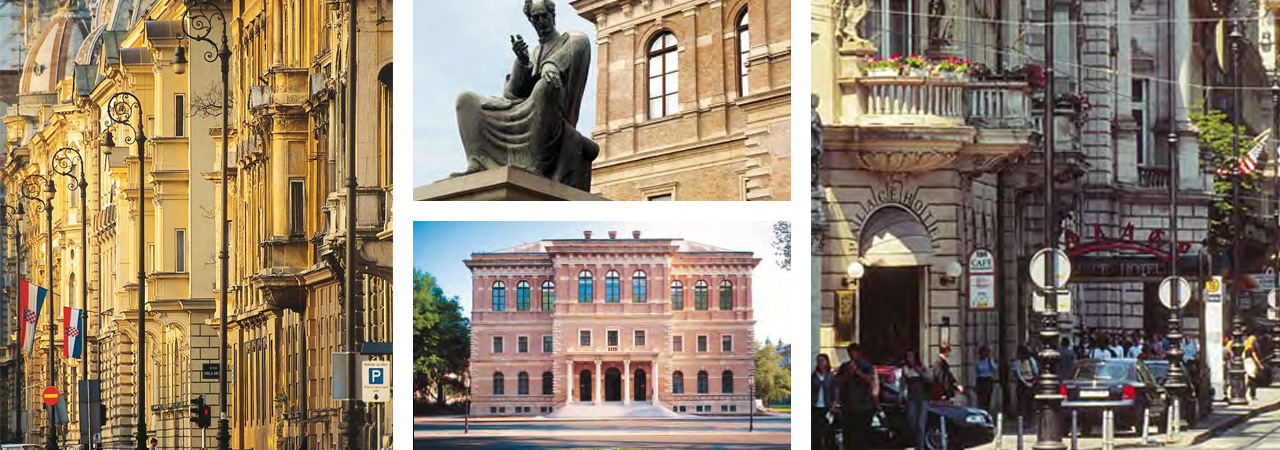
A must see
How many times must you have passed through this square without stopping, and how many more times could you still pass it and remain unaware of its beauty and everything it has to offer? Yet however beautiful its façades may be, however inviting the park, Strossmayer Square is much more than just a peaceful space of superficial beauty.
In the park, you are surrounded by the busts of eminent Croatian personalities, with pride of place going to Bishop Strossmayer’s monument, created by the equally famous Croatian sculptor, Ivan Meštrović. The palace housing the Gallery of Modern Arts, the temple of Croatian 19th and 20th century art, accommodates another precious collection in
the Department of Prints and Drawings of the Croatian Academy of Science and Arts. The Strossmayer Gallery, housed in the building of the Croatian Academy of Science and Arts, holds the works of famous artists, mostly belonging to various Italian schools of painting, as well as masterpieces by the likes of El Greco, Goya and many others.
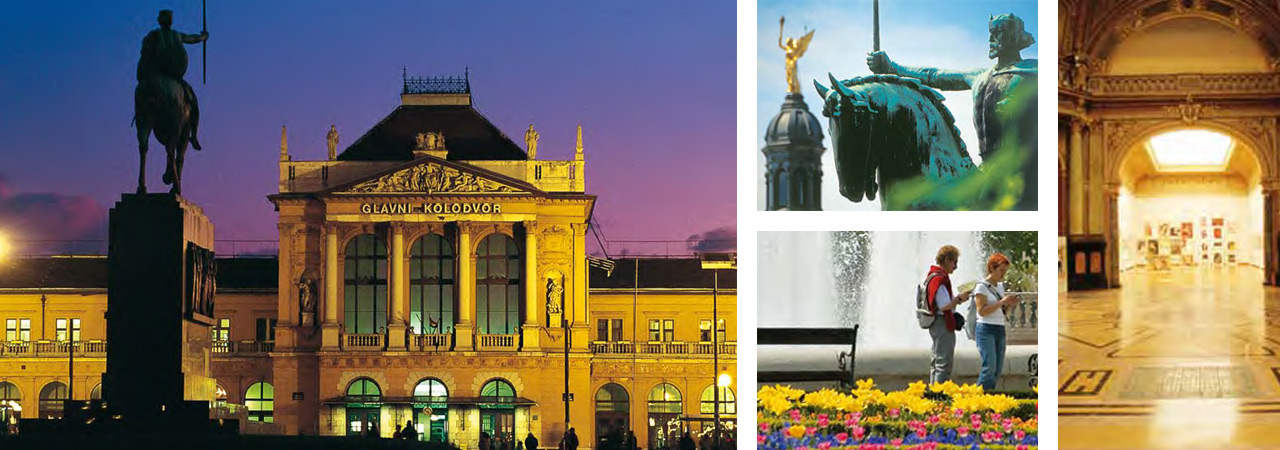
In your experience, it is quite possible that railway stations are rather gloomy and unattractive places – but Zagreb’s might just make you change your mind. Or at least concede that what you find here is an exception.
Another word for welcome
The building of the main railway station has born quiet witness to many human destinies, to departures and arrivals. Has it ever occurred to you how many people have passed through it since it was built at the end of the 19th century? For the many guests of Zagreb, the railway station building is their first encounter with the city, and the monument to King Tomislav, the first medieval Croatian king, is something they will recognise from the tourist guides as one of the symbols of the city. As you look down the square, across from the equestrian monument, the park seems closed off by the Art Pavilion.
Another water fountain in the park that bears the name of the Croatian politician and writer, Ante Starčević, and a splendid building, the legendary landmark which is the epitome of Zagreb’s hospitality industry: the Esplanade Hotel.

A place to take a short break or make a final stop, a place to learn more about nature or find a shaded, seculed spot in which to take out your book and read – the Botanical Gardens are all of this and more. Despite their central location, they exude an atmosphere which is far removed from the hectic rhythm of city life.
Man and nature
The Botanical Gardens, with its refurbished Garden Pavilion, contains as many as ten thousand plants from all four corners of the globe, each of them special, beautiful and interesting in their own way. One section of the Botanical Gardens has been landscaped in the style of what Croatians term an English park, that is to say with little winding paths and free-standing groups of trees and shrubs. Another section features the strict symmetrical forms and straight lines more in keeping with a park of French style. Having crossed the road from the Botanical Gardens, you find yourself on Marulić Square, dominated by a monument to the Croatian writer who has given this spot his name. The area is also adorned by a masterpiece of artdeco architecture, the Former National and University Library, which is currently housing the State Archives of Croatia.

A gift to art lovers
At Roosevelt Square sit down for a moment and take in the beauty of a former lycée, with its floral patterns in the foreground, another element to add to your initial impressions of Zagreb. Venture a bit further and open the door of the treasury of art that is the Mimara Museum and find yourself face-toface with priceless exhibits which echo faraway worlds.
When you embark on the adventure to explore the treasures of the Mimara Museum, you will become familiar with one of the richest art collections in Europe. As many as 3,750 varied and valuable works of art cover many millennia, dating from the prehistoric period and running right up to the 20th century.
The exhibits in the Mimara Museum were donated to the nation and Zagreb by the collector, painter and restorer, Ante Topić Mimara. Having offered this invaluable collection to Croatia, his homeland, and in particular to Zagreb, Mimara allows Zagreb to share it all in turn with any visiting lover of art.
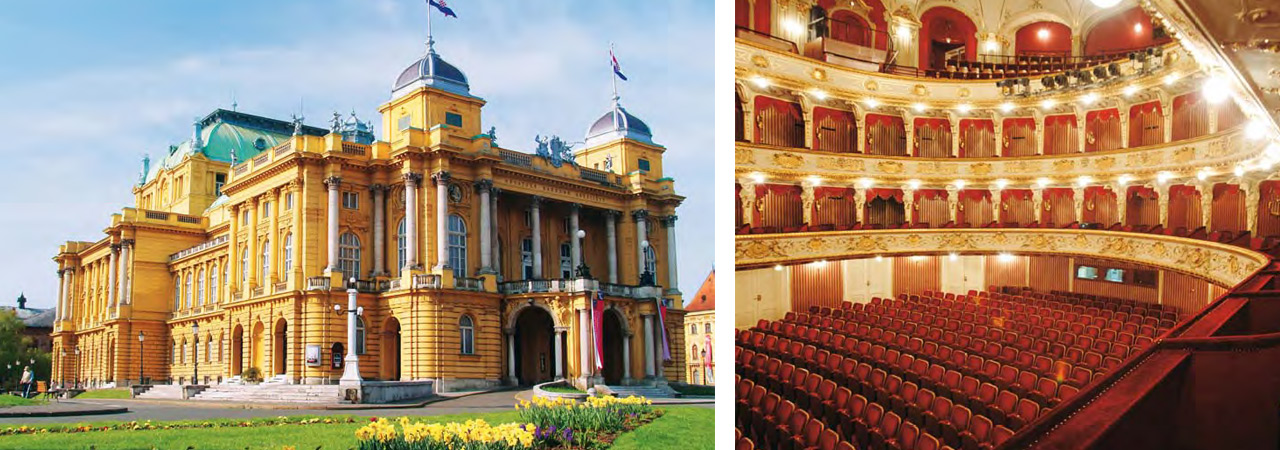
The Croatian National Theatre is another key symbol of Zagreb. When night falls upon the streets and squares of the city, another life is starting here – on stage. It has been this way since 1895, when the Habsburg Emperor Franz Josef ceremoniously opened the theatre with a silver hammer as if saying: ‘Let the show go on’.
Let the show go on
The neo-Baroque building is the centrepiece and symbol of Marshal Tito Square, where the Well of Life by sculptor Ivan Meštrović is another striking feature. The atmosphere generated by the Croatian National Theatre is not only as a result of its memorable façade and outer beauty – it
derives from the illusion of worlds and destinies changing right before your eyes, created at the hands of inspired artists. This ambience surrounds the Well of Life monument and the nearby Zagreb University building which always seems to be swarming with young people, and happens to be proudly guarded by another of Meštrović’s sculptures, the History of the Croats. Even the nearby Theatre Café exudes its own special atmosphere.
Lure of stage lights
The theatre stage is the place where reality gives over to the world of the imagination and where any number of human stories blend into one. You may not recall who first opened the door to this world for you, but you will remember how you entered, quietly and on tiptoes.
When the soft street lights start to diffuse the darkness, when the frenzy of urban life dies down, the curtain is lifted to reveal the magical world of theatre. The famed masters of the spoken word, sound and movement appearing either in classic masterpieces or avant-garde shows are ready to entertain packed houses with their marvellous performances.
Comedy or tragedy, one-act plays or long-running popular dramas, operas or musicals, classical ballet or modern dance, the contemporary scene or puppet shows for children – the choice is yours and sometimes hard to make. Every theatre has its repertoire, and combined they contribute to the wealth of Zagreb’s cultural life.
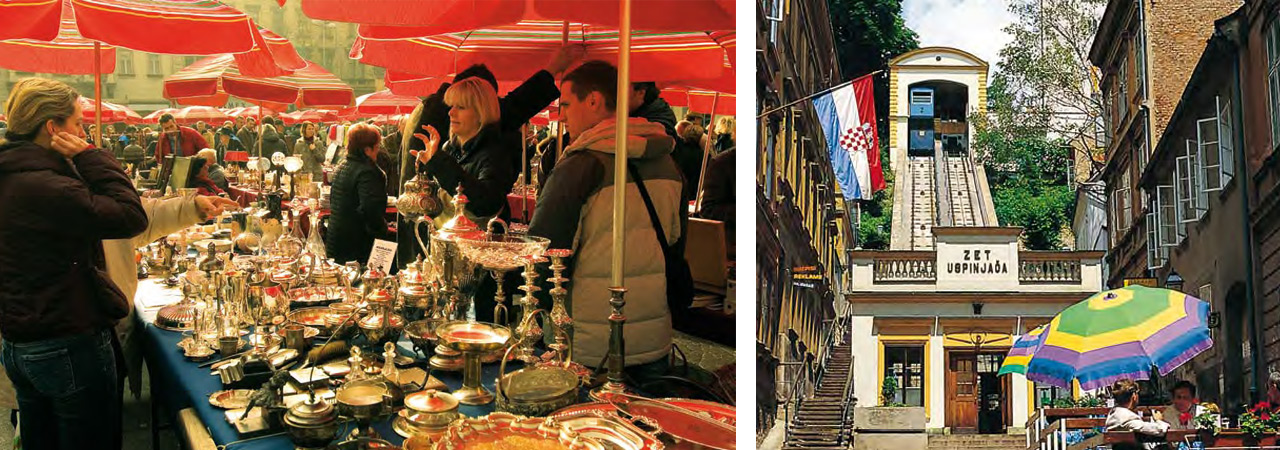
Ilica is the backbone of Zagreb. It can be measured either in simple kilometres or by the number of chance encounters that happen down it every day. You will never see it deserted – there is always traffic down it, whether it is just passers-by, young businessmen with their briefcases, flirty girls with their eyes cast on the glittering merchandise in the shop windows, or humming trams on the night shift.
Ilica – a street that never ends
The street was first mentioned more than five centuries ago. Ever since, Ilica has grown together with the city of Zagreb. Ilica is dynamic whatever the time of day or night. Just a few steps away from Ilica is the city’s funicular, forever shuttling up and down between just two stops, the shortest link between the Lower Town and Upper Town. At the upper terminus, you will find yourself at the foot of Lotrščak, the 13th-century defence tower. This monument is pretty hard to miss, but even if you fail to see it, you will certainly hear it, however strange this might sound at first. For more than a century, the cannon mounted at the very top of the tower has been fired at noon every day. On Sundays, a leisurely stroll or a short tram ride down Ilica will bring you to an antique fair.
On display you will find little treasures from a grandmother’s chest of drawers, remnants of a bygone ages, keepsakes that will tell you stories of their owners and their destinies. Lined with shop windows and restaurants, cafés and pastry shops, Ilica is comprised of living elements that give the street its own special character.

Souvenirs and good-luck charms
Taking a walk through a city inevitably means coming face-to-face with its shop windows and its stores. Zagreb has a lot to offer where commerce is concerned. There are an impressive number of Croatian labels and hallmarks, products created in this country that are picked up by visitors to be enjoyed around the world.
These Croatian commodities range from the fashionable to the practical – they could be a cravat or a mechanical pen, the so-called penkala, both original Croatian inventions; the cravat is tied in with Croatia’s renown across Europe from medieval times. Zagreb’s luxuriously presented stores and galleries, gleaming shopping malls and quaint boutiques display both domestic talent and international brand names in their windows for your perusal. Whatever it happens to be, you will be taking a piece of Zagreb home with you. Small family businesses, even in the city centre, are still prevalent – although you will also find all the glamorous international chains you would also see on the streets of London, Paris or Barcelona.

After all that browsing and shopping, you’ve earned yourself a break. Grab a seat somewhere, have a chat with a local or a fellow passer-by, stop to enjoy a decent cup of coffee and after a while, you can move on again. As you relax between errands, whether you’re waiting for a friend or just gazing at the people strolling by from the terrace of one of the many cafés around the pedestrianised zone right by the main square, you realise what they’re talking about when they call Zagreb a city with soul.
Step by step
When they are going window-shopping or moving in sync with the afternoon rhythm of the city, the citizens of Zagreb follow their instincts which take them to the heart of town, to Ban Josip Jelačić Square, Ilica and, around Flower Square, to the streets of Gajeva or Bogovićeva. Here, without the bustle of city-centre traffic, locals stop at their favourite spots and meet people they have bumped into for years. These are the places where people treat themselves to an afternoon drink, meet with friends and acquaintances or just sit and watch the endless stream of passers-by flowing through the streets of Zagreb. These daily rituals are part of this city’s personality and something that the first-time visitor picks up on pretty quickly.

Citizens of Zagreb give flowers for every occasion – not only birthdays, anniversaries and celebrations but for a theatre performance, as an unexpected gift or a show of affection. When Ilica, the longest and busiest street in Zagreb, casts away its professional and sober attire, and power suits are replaced by casual elegance, the name Flower Square comes to take on an added significance.
Flowers, flowers everywhere
Petar Preradović Square, as it is given to those looking at city maps or reading street signs, is Flower Square to those who call Zagreb home. This is the place where you have your afternoon cup of coffee, where you rest your feet during a shopping spree, where you can buy your flowers late at night or just delight in their scents and colours as you walk past. The whole square is a big terrace and it is hard to know where one café starts and the other ends. Whichever you choose, you will be surrounded by bright flowers and the songs of passing street performers. Its permanent inhabitant, for more than a century now, is Petar Preradović, the great revival poet of the 19th century and an connoisseur of the human soul. If your intention is to keep a low profile and pass unnoticed through town on a Saturday, you will be well advised to avoid Flower Square. If, on the other hand, you are eager to see somebody, anybody, this is precisely where you want to be headed for, your path lined with bright colours and wonderful scents. Petar Preradović is one of those squares where words are not needed to describe its charm and beauty.

They pass by us every day, all of them living in the same city, and each and every one of them is different. A gentleman in a hat sits in the same place every day, right on the stroke of noon, sipping coffee with his friends. There is no end to the discussions about who voted for who in the most recent elections, who won and who lost in the games of politics and football, whose numbers were drawn in the lottery – so many topics go on and on.
People come and go, cafés stay
Unlike those who seek company to fill their moments of leisure with entertainment and gossip, there are also the solitary types who find the daily papers to be their best coffee-break companions. Newspaper holders and fancy table lamps have always been symbols of the most romantic meeting spots in Zagreb.
New generations will come, but as youngsters they surely wonder how anybody in their right mind could ever look for better company than their computer or a more fulfilling world than the captivating one of the internet. And as they ponder on this, a very special virtual meeting happens online, e-mail addresses are exchanged and then, a convenient time will be set for something more than just a virtual chance encounter – which is when the café comes into play. And this will be a new beginning, the beginning of a story of yet another coffeehouse.
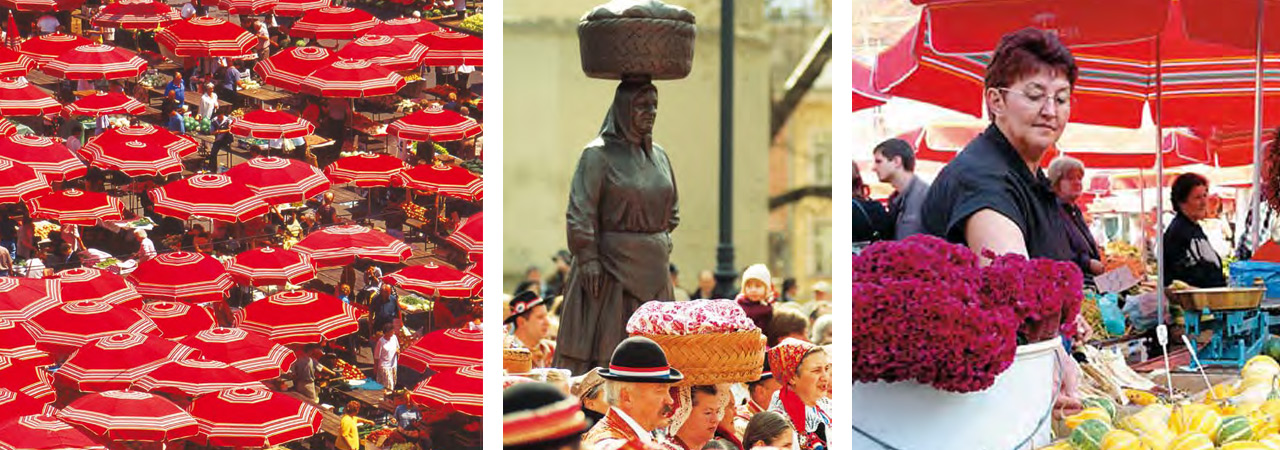
If you want to get to the roots of the city, head to its biggest open-air market, the Dolac, conveniently located above the main square. The belly of Zagreb is a colourful site adorned with bright parasols; a wonderful choice of fruit, vegetables, flowers and souvenirs arranged on rows of stalls; and vendors in their different clothes typical of the region they come from.
Scents and flavours of nature
Here you can savour the sweet fragrances of fruit which grow in long-established rural orchards, and you can smell the sea at the fishmongers’ stalls around the recently renovated Ribarnica. Shopping for food at the Dolac is a ritual for many citizens of Zagreb and visitors in the know. The Dolac is not just a place where you go to buy fresh goods, it is where friends and acquaintances meet, especially on Saturdays. The usual business, politics and other topics are replaced by lighter subjects, more appropriately suited to the leisurely weekend that lies ahead: that day’s best buys at the Dolac; the time-tested recipes which will supply the Sunday dinner table; a recommendation for a good restaurant, or a destination for a day out which must not be missed. An integral part of the Saturday ritual is to sit over a coffee on the terrace overlooked by Kerempuh, the vagabond of lore in statue form, and talk over old times.

A flowing street
Only a few steps away from the main city square, the downtown bustle disappears as if by magic. If you want to experience Zagreb at its most relaxed, you should head to Tkalčićeva Street, lined with cafés, bars and restaurants, a beloved meeting place of the citizens of Zagreb and any visitor just passing through.
Here it is as if time has stood still. What used to be a stream called Medveščak was converted into a street; and these days a different kind of change is taking place in this locality. Glimpses of ramshackle old houses unchanged for decades peek through the colourful parasols of the many café terraces; brash new businesses and galleries stand beside age-old establishments. One thing hasn’t changed,
though: the statue of Marija Jurić Zagorka, the popular writer and faithful chronicler of Zagreb, who stands halfway down, still observing the constant to-and-fro of her fellow citizens. Whether it’s a run-of-the-mill modern-day business, or a specialist boutique displaying old customs and crafts, the overall array of restaurants, cafés, galleries and little shops gives Tkalčićeva a nostalgic atmosphere – it feels as if it has been here forever.
